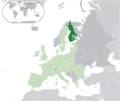Knowledge fuels change - Support energypedia!
For over 10 years, energypedia has been connecting energy experts around the world — helping them share knowledge, learn from each other, and accelerate the global energy transition.
Today, we ask for your support to keep this platform free and accessible to all.
Even a small contribution makes a big difference! If just 10–20% of our 60,000+ monthly visitors donated the equivalent of a cup of coffee — €5 — Energypedia would be fully funded for a whole year.
Is the knowledge you’ve gained through Energypedia this year worth €5 or more?
Your donation keeps the platform running, helps us create new knowledge products, and contributes directly to achieving SDG 7.
Thank you for your support, your donation, big or small, truly matters!
Difference between revisions of "Finland Energy Situation"
***** (***** | *****) m |
***** (***** | *****) |
||
| Line 1: | Line 1: | ||
| + | |||
{{CES Country | {{CES Country | ||
|CES Country Name=Finland | |CES Country Name=Finland | ||
| Line 7: | Line 8: | ||
= Introduction = | = Introduction = | ||
| + | |||
Finaland is a net energy importer and does not have its own indigenous hydrocarbon energy resources. Thus, energy security is always at the heart of the Finish government's energy policy.With its energy intensive industries and the cold climate, Finaland's energy consumpiton per capita is very high. <ref>Retrieved from : http://www.iea.org/Textbase/npsum/finland2013SUM.pdf </ref> | Finaland is a net energy importer and does not have its own indigenous hydrocarbon energy resources. Thus, energy security is always at the heart of the Finish government's energy policy.With its energy intensive industries and the cold climate, Finaland's energy consumpiton per capita is very high. <ref>Retrieved from : http://www.iea.org/Textbase/npsum/finland2013SUM.pdf </ref> | ||
= Energy Situation = | = Energy Situation = | ||
| − | |||
= Renewable Energy = | = Renewable Energy = | ||
| − | + | = Fossil Fuels = | |
| − | = Fossil | ||
| − | |||
= Key Problems of the Energy Sector = | = Key Problems of the Energy Sector = | ||
| − | |||
= Policy Framework, Laws and Regulations = | = Policy Framework, Laws and Regulations = | ||
| − | |||
= Institutional Set up in the Energy Sector = | = Institutional Set up in the Energy Sector = | ||
| + | = <span style="background-color: rgb(255, 255, 255);">Other Key Actors / Activities of Donors, Implementing Agencies, Civil Society Organisations</span> = | ||
= References = | = References = | ||
| − | |||
| + | <references /> | ||
| + | |||
| + | [[Category:Europe_and_Central_Asia]] | ||
[[Category:Finland]] | [[Category:Finland]] | ||
| − | |||
Latest revision as of 08:18, 18 September 2018
Capital:
Helsinki
Region:
Coordinates:
64.0000° N, 26.0000° E
Total Area (km²): It includes a country's total area, including areas under inland bodies of water and some coastal waterways.
XML error: Mismatched tag at line 6.
Population: It is based on the de facto definition of population, which counts all residents regardless of legal status or citizenship--except for refugees not permanently settled in the country of asylum, who are generally considered part of the population of their country of origin.
XML error: Mismatched tag at line 6. ()
Rural Population (% of total population): It refers to people living in rural areas as defined by national statistical offices. It is calculated as the difference between total population and urban population.
XML error: Mismatched tag at line 6. ()
GDP (current US$): It is the sum of gross value added by all resident producers in the economy plus any product taxes and minus any subsidies not included in the value of the products. It is calculated without making deductions for depreciation of fabricated assets or for depletion and degradation of natural resources.
XML error: Mismatched tag at line 6.2 ()
GDP Per Capita (current US$): It is gross domestic product divided by midyear population
XML error: Mismatched tag at line 6. ()
Access to Electricity (% of population): It is the percentage of population with access to electricity.
XML error: Mismatched tag at line 6.no data
Energy Imports Net (% of energy use): It is estimated as energy use less production, both measured in oil equivalents. A negative value indicates that the country is a net exporter. Energy use refers to use of primary energy before transformation to other end-use fuels, which is equal to indigenous production plus imports and stock changes, minus exports and fuels supplied to ships and aircraft engaged in international transport.
XML error: Mismatched tag at line 6.no data
Fossil Fuel Energy Consumption (% of total): It comprises coal, oil, petroleum, and natural gas products.
XML error: Mismatched tag at line 6.no data
Introduction
Finaland is a net energy importer and does not have its own indigenous hydrocarbon energy resources. Thus, energy security is always at the heart of the Finish government's energy policy.With its energy intensive industries and the cold climate, Finaland's energy consumpiton per capita is very high. [1]
Energy Situation
Renewable Energy
Fossil Fuels
Key Problems of the Energy Sector
Policy Framework, Laws and Regulations
Institutional Set up in the Energy Sector
Other Key Actors / Activities of Donors, Implementing Agencies, Civil Society Organisations
References
- ↑ Retrieved from : http://www.iea.org/Textbase/npsum/finland2013SUM.pdf





















